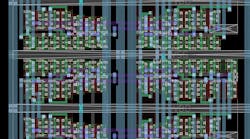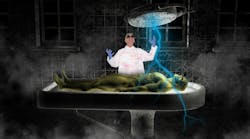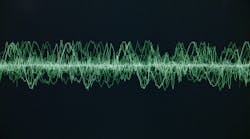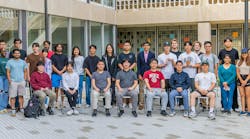How to Design a Chip for Under $1,000 (Part 1): Book Recommendations
What you’ll learn:
- TinyTapeout offers a course that provides an overview of basic circuit components, guiding the student through schematic, simulation, layout, back annotation, DRC, and tapeout, with the student’s design fabricated in 130-nm CMOS.
- Books and peer-reviewed papers are an excellent resource for understanding the details of component and circuit operation, with some providing examples.
- A list of seven selected books on analog chip design, along with a downloadable table of contents for each.
One thousand dollars
Is all you need for a chip?
Go read a good book
“With the TinyTapeout philosophy of anyone being able to design a chip, and with the online class teaching chip design all the way from tools installation through tapeout and evaluation of a chip, I signed up for the beta version of the course. I did this primarily to be able to share this experience with our readers who may be interested in creating an obscure, discontinued, or original-design analog, digital, or mixed-signal chip.”—Andy Turudic, Nonlinearities Blog
TinyTapeout, and Open-Source tools and PDKs (Process Design Kits) now make it possible to view a class on chip design procedure and then design, simulate, layout, tapeout, fab, and receive prototypes of a custom ASIC, comprised of digital, analog, or mixed-signal circuits, for under $1,000.
The first step in the process toward getting your own custom-designed chip onto your workbench is to assemble the necessary technology libraries so that the design phase can proceed. Whether it’s analog, digital, or mixed-signal design, they all start with basic circuit elements—MOS and/or bipolar transistors, resistors, capacitors, inductors, varactor diodes, small signal diodes, and interconnect wiring. These components are usually described in a library, which takes a bit of time, and money, to establish.
Dewy or Don’t We?
Two types of libraries need to be in place to successfully design a chip. While the first thought about getting a library in place leans toward installing symbols and layout primitives to be able to start CAD design, the first library that I think is essential consists of books and papers related to the type of chip design you have in mind.
Books and peer-reviewed papers serve as great references, allowing a designer to stand on the shoulders of previous designers’ circuits and their knowledge, and to gain insight on how circuit functional blocks and components actually work. This is important for the schematic capture, simulation, and circuit layout phases of making a custom chip. We’ll concentrate on Analog and Digital design for now and leave design synthesis of digital circuits for some other time.
The books and resources listed here are by no means comprehensive and not in any particular ranked order. Any suggestions you may have for books that I haven’t listed are more than welcome in the comments area of this page. I'll update the list here in this article if you suggest a really good tome, as it’s a bit disruptive to change things after they’re posted.
Passing GaAs
I’d been doing chip design on and off for a couple of decades, though I was on the product definition side as far as defining the device functionality, pin specs, timing, and signal-integrity functionality that was needed. I was fortunate to work with very highly competent teams of silicon and gallium-arsenide (GaAs) design engineers who did the actual transistor-level design, layout, and tapeout stuff. That, looking in the mirror of this project’s context, was luxury.
My GaAs stuff started around 1987, when I took an internal GaAs design course from John Sitch and Paul Jay while we were at Bell-Northern Research. It included a look at the cell layouts of our MESFET transistor-based standard cells.
I used that GaAs knowledge to manage Phase 1 of DARPA/NSF/ITO-funded teams at Bellcore, AT&T Bell Labs (Lucent), and Rockwell Science Center to develop the first byte-wise analog front end (AFE), optical components, and SERDES for 10-Gb/s SONET, which was done in a crazy-fast (in 1991) 50-GHz Ft GaAs HBT process. I also was the architect of a couple of GaAs crosspoint switches; the circuit designer and I published a paper on one of them at the GaAs IC Symposium.
Those are about the closest I’ve gotten to actually physically designing a complete chip—so almost there, but not quite.
That said, it’s been several decades since we learned about MOS devices in school, and almost four decades since I took the GaAs IC design course. It’s also been a couple of decades since we did a GaAs chip metals-only fix at TriQuint to slide in an omitted flip-flop at the expense of a minor chip feature to get the chip into customer hands on time. The TinyTapeout package does include a class, but it’s not quite enough, in my opinion, to do more than basic CMOS analog functions.
That means I need to review and reuse as much as is out there to get to tapeout with something that might work. The best part of TinyTapeout, apart from the low cost to fabricate a chip, is that all submissions are Open Source.
For example, if someone has taped out an Op Amp, all of their design files are available for you to build on for your very own servo-controller chip. Someone down the road, then, could use your work to build a 5-axis CNC controller, including embedding the VHDL for a microprocessor like RISC-V or a Z-80. However, the circuit elements and blocks that aren't there means finding relevant papers (I use Google Scholar for this part) and acquiring textbooks as references.
So, here’s a list of some of the books I plan to use during the design process for the planned analog/digital chip (I still haven’t decided what specific chip to do just yet, though I’m thinking about doing a high-frequency prescaler; maybe try and hit those 1990s GaAs MESFET speeds).
After each author and title in the listing, I’m also including the table of contents in a downloadable PDF file, which should give you a better idea of the material covered in each book.
The Magnificent Seven
Again, these are in no particular order (each entry has a Table of Contents file embedded right below it); a few of the titles are considered “the classics” by many IC designers and engineering professors:
1. Razavi, Behzad. Design of Analog CMOS Integrated Circuits
3. Weste, Neil; Harris, David. CMOS VLSI Design: A Circuits and Systems Perspective
4. Marzuki, Arjuna. CMOS Analog and Mixed-Signal Circuit Design
6. Gray, Paul R. et al. Analysis and Design of Analog Integrated Circuits
7. Franco, Sergio. Analog Circuit Design: Discrete & Integrated
Books can be a substantial cost component of your custom-chip design project, so shop around to find the best deals. Those lucky enough to live near a university can avail themselves of the school’s engineering library, or prey on starving students that sell their textbooks off at the end of their semester.
In the next installment of the How to Design a Chip for Under $1,000 series, I’ll show you how to install the technology library and Open-Source toolset onto your computer, so clear off several dozen gigs of space off your hard drive if you plan on doing the next steps.
All for now,
-AndyT
Andy's Nonlinearities blog arrives the first and third Monday of every month. To make sure you don't miss the latest edition, new articles, or breaking news coverage, please subscribe to our Electronic Design Today newsletter.
About the Author
Andy Turudic
Technology Editor, Electronic Design
Andy Turudic is a Technology Editor for Electronic Design Magazine, primarily covering Analog and Mixed-Signal circuits and devices. He holds a Bachelor's in EE from the University of Windsor (Ontario Canada) and has been involved in electronics, semiconductors, and gearhead stuff, for a bit over a half century.
"AndyT" brings his multidisciplinary engineering experience from companies that include National Semiconductor (now Texas Instruments), Altera (Intel), Agere, Zarlink, TriQuint,(now Qorvo), SW Bell (managing a research team at Bellcore, Bell Labs and Rockwell Science Center), Bell-Northern Research, and Northern Telecom and brings publisher employment experience as a paperboy for The Oshawa Times.
After hours, when he's not working on the latest invention to add to his portfolio of 16 issued US patents, he's lending advice and experience to the electric vehicle conversion community from his mountain lair in the Pacific Northwet[sic].
AndyT's engineering blog, "Nonlinearities," publishes the 1st and 3rd monday of each month. Andy's OpEd may appear at other times, with fair warning given by the Vu meter pic.






